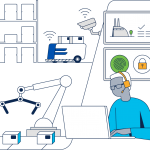My colleague Kevin Davenport was quoted in a recent AutomationWorld article “Connecting Expertise along Supply Chain,” highlighting a number of use case scenarios where mobile advisor and remote expert solutions for manufacturing can and have enhanced business performance and outcomes across the supply chain. These improvements include:
- Greater field service effectiveness and reduce warranty costs—by offering real-time, scheduled, or impromptu access to SMEs via a pervasive video platform;
- Stronger supplier relationships— by establishing effective, immersive B2B TelePresence conferencing;
- New products to market faster, with a improved product launch processes—by using video-immersive collaboration to foster dynamic cross-business unit and development supply chain integration; and
- Higher velocity, more effective response to plant-floor issues through fast deployment of both internal and external technical and SME support.
Examples include Jabil, Coca Cola, Puma, and our most recently featured IoE customer case study example with Stanley Black & Decker (SB&D), which demonstrates how Cisco Connected Factory Wireless capabilities, in concert with AeroScout Industrial real-time location services, are used to pinpoint issues—alongside people-and-process context—for much quicker resolution, yielding double-digit throughput and productivity improvements. Check out this video, for more on the SB&D case and results:
Recently, I spoke with Roberto Michel, Editor-at-Large for Modern Materials Handling, on “4 ways the Internet of Things will reshape Manufacturing” where we discuss those areas within a production operations environment:
- Equipment monitoring and optimization;
- Process, Machine and Occupational Safety;
- Materials tracking for WIP visibility, agility; and
- Lifecycle product traceability.
The connected factory IoT infrastructure built to support these business outcomes can be broadened with an architecture that converges supply chain linkages with production plants, to drive even greater value—compounded savings, cost avoidance and upside revenues—utilizing more unique services across the enterprise.
When we pull together IoE/IoT capabilities that more seamlessly integrate enterprise with factory workflow, visibility, quality and throughput interests—combining the supply chain use case scenarios Kevin talks about with the plant capabilities I’ve referred—we really start to transform the entire manufacturing value chain, driving breakaway business outcomes.

CONNECT WITH US